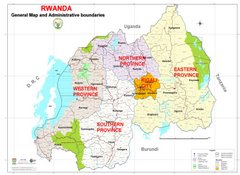By Emmanuel Mungwarakarama
On a warm sunny day, I arrive in Gakoni sector, Kiramuruzi district in the Eastern Province, well equipped to find out how the survivors and perpetrators of the 1994 Genocide are coping up. The area, though typical of Rwanda’s hilly topography, is not made up of very steep hills.
They are generally undulating and gently rolling plains in others. Gilbert Karimunda runs a small shop. He looks a grown up man but not very old, with dotted splashes of grey hair scattered over his head. He wears a constant warm smile. I go close to him; introduce my self and business unusual gets underway. Karimunda is a genocide survivor from the nearby school; he tells a story of how the genocide occurred, and, twelve years after, the developments and challenges on the ground.
He tells his tale thus;
In April 1994, Jean Baptiste Gatete, the then mayor of Murambi District, promised protection to the Tutsi of the area if they gathered at that school. About forty thousand of them sought shelter and in the course of just four days, they were all massacred. Their bodies were thrown into pits and covered with lime.
Karimunda--a tall majestically looking man points in the direction of the school and says that he is one of the only four survivors of the massacre. He has a big scar at his forehead where a bullet ripped off the skin.
Karimunda tells his story of Rwanda with deep pain. He remembers the early days of the Genocide when he travelled from Murambi to Kigali, “when I reached Kigali, I found out that the presidential guard had just initiated a campaign of retribution, which was after the death of Habyarimana. Leaders of the political opposition were murdered, and almost immediately, the slaughter of Tutsis and moderate Hutus began.”
The seemingly hurt Karimunda remembers the time when, within hours, recruits were dispatched all over the country to carry out a wave of slaughter. He also remembers the organization of the genocide saying that the early organizers included military officials, politicians and businessmen, but soon many others joined in the mayhem.
He also says that when he returned home, the whole village had caught fire; there was a frenzy of people crying and a cacophony of gunfire everywhere. “I was told that Gatete was looking for me and just before my escape, they caught me and took me to the school.”
As tears well in his eyes, Karimunda says, “The story of the school is a horrific one; I will not tell you, just look at the scar, and I am one of the four people who survived.” He says as he shows me the big scar on his forehead.
After noting Karimunda’s horrendous tale, I approach another female survivor Chantal Umurungi, 54, who gives her dreadful version of the turmoil.
“I don’t want to talk about genocide. I saw the blood of my children and my husband. My daughter was raped; my husband I loved so much was terribly killed. I don’t want to spend much time talking about it.”
Umurungi also says that she still wants to live. That’s why she doesn’t want to talk much about the Genocide.
“It is difficult to forget,” says Umurungi the only survivor and a mother in a family of 10, “I keep remembering how the militias were cutting off people’s heads which usually comes in the form of nightmares.”
She also says that rape cases were sometimes followed by sexual mutilation, including mutilation of the vagina and pelvic area with machetes, knives, sticks, boiling water, and in one case, acid.
Umurungi believes that justice would help in unity and reconciliation but rather skeptical about the slow pace the process is taking.
“We feel that justice has been too slow and in some cases unfair. To us the survivors, it has been a double agony to lose our loved ones and to have no justice done.”
Monday, June 28, 2010
Subscribe to:
Post Comments (Atom)
Rwanda

Administrative map
Blog Archive
-
▼
2010
(59)
- ► 09/19 - 09/26 (1)
- ► 07/11 - 07/18 (5)
- ► 07/04 - 07/11 (5)
- ▼ 06/27 - 07/04 (4)
- ► 06/20 - 06/27 (6)
- ► 06/06 - 06/13 (17)
- ► 05/30 - 06/06 (4)
- ► 03/28 - 04/04 (2)
- ► 02/28 - 03/07 (3)
- ► 02/21 - 02/28 (5)
- ► 01/24 - 01/31 (2)
- ► 01/17 - 01/24 (4)
- ► 01/10 - 01/17 (1)
-
►
2009
(25)
- ► 11/08 - 11/15 (9)
- ► 10/04 - 10/11 (2)
- ► 01/25 - 02/01 (2)
- ► 01/18 - 01/25 (12)
-
►
2008
(55)
- ► 12/28 - 01/04 (1)
- ► 12/21 - 12/28 (11)
- ► 12/14 - 12/21 (3)
- ► 12/07 - 12/14 (5)
- ► 11/30 - 12/07 (2)
- ► 11/16 - 11/23 (22)
- ► 11/09 - 11/16 (4)
- ► 07/13 - 07/20 (1)
- ► 06/01 - 06/08 (6)
-
►
2007
(19)
- ► 05/20 - 05/27 (2)
- ► 04/01 - 04/08 (1)
- ► 03/04 - 03/11 (1)
- ► 02/25 - 03/04 (2)
- ► 02/18 - 02/25 (2)
- ► 02/11 - 02/18 (6)
- ► 02/04 - 02/11 (3)
- ► 01/28 - 02/04 (2)
-
►
2006
(59)
- ► 10/22 - 10/29 (12)
- ► 10/15 - 10/22 (1)
- ► 10/08 - 10/15 (2)
- ► 09/03 - 09/10 (2)
- ► 08/27 - 09/03 (6)
- ► 07/09 - 07/16 (7)
- ► 06/18 - 06/25 (1)
- ► 04/09 - 04/16 (5)
- ► 04/02 - 04/09 (23)
No comments:
Post a Comment